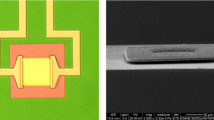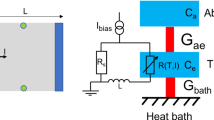Abstract
We are developing kilo-pixel arrays of transition-edge sensors (TESs) for the X-ray Integral Field Unit on ESA’s Athena observatory. Previous measurements of AC-biased Mo/Au TESs have highlighted a frequency-dependent loss mechanism that results in broader transitions and worse spectral performance compared to the same devices measured under DC bias. In order to better understand the nature of this loss, we are now studying TES pixels in different geometric configurations. We present measurements on devices of different sizes and with different metal features used for noise mitigation and X-ray absorption. Our results show how the loss mechanism is strongly dependent upon the amount of metal in close proximity to the sensor and can be attributed to induced eddy current coupling to these features. We present a finite element model that successfully reproduces the magnitude and geometry dependence of the losses. Using this model, we present mitigation strategies that should reduce the losses to an acceptable level.








Similar content being viewed by others
References
D. Barret et al., Proc. SPIE 9905, 99052F (2016). https://doi.org/10.1117/12.2232432
S. J. Smith et al., Proc. SPIE 9905, 99052H (2016). https://doi.org/10.1117/12.2231749
L. Gottardi et al., IEEE Trans. Appl. Supercond. 27, 4 (2017). https://doi.org/10.1109/TASC.2017.2655500
J.N. Ullom et al., Appl. Phys. Lett. 84, 2 (2004). https://doi.org/10.1063/1.1753058
M.A. Lindeman et al., Nucl. Instrum. Methods Phys. Res. 520, 1 (2004). https://doi.org/10.1016/j.nima.2003.11.264
M.P. Bruijn et al., J. Low Temp. Phys. 167, 5 (2012). https://doi.org/10.1007/s10909-011-0422-5
M. Kiviranta, L. Grönberg, N. Beev, J. van der Kuur, J. Phys. Conf. Ser. 507, 4 (2014). https://doi.org/10.1088/1742-6596/507/4/042017
J.E. Sadleir et al., Phys. Rev. Lett. 104, 047003 (2010). https://doi.org/10.1103/PhysRevLett.104.047003
S.J. Smith et al., J. Appl. Phys. 114, 7 (2013). https://doi.org/10.1063/1.4818917
L. Gottardi et al., J. Low Temp. Phys. 176, 3 (2014). https://doi.org/10.1007/s10909-014-1093-9
D.S. Swetz, D.A. Bennett, K.D. Irwin, D.R. Schmidt, J.N. Ullom, Appl. Phys. Lett. 101, 2 (2012). https://doi.org/10.1063/1.4771984
Author information
Authors and Affiliations
Corresponding author
Rights and permissions
About this article
Cite this article
Sakai, K., Adams, J.S., Bandler, S.R. et al. Study of Dissipative Losses in AC-Biased Mo/Au Bilayer Transition-Edge Sensors. J Low Temp Phys 193, 356–364 (2018). https://doi.org/10.1007/s10909-018-2002-4
Received:
Accepted:
Published:
Issue Date:
DOI: https://doi.org/10.1007/s10909-018-2002-4




